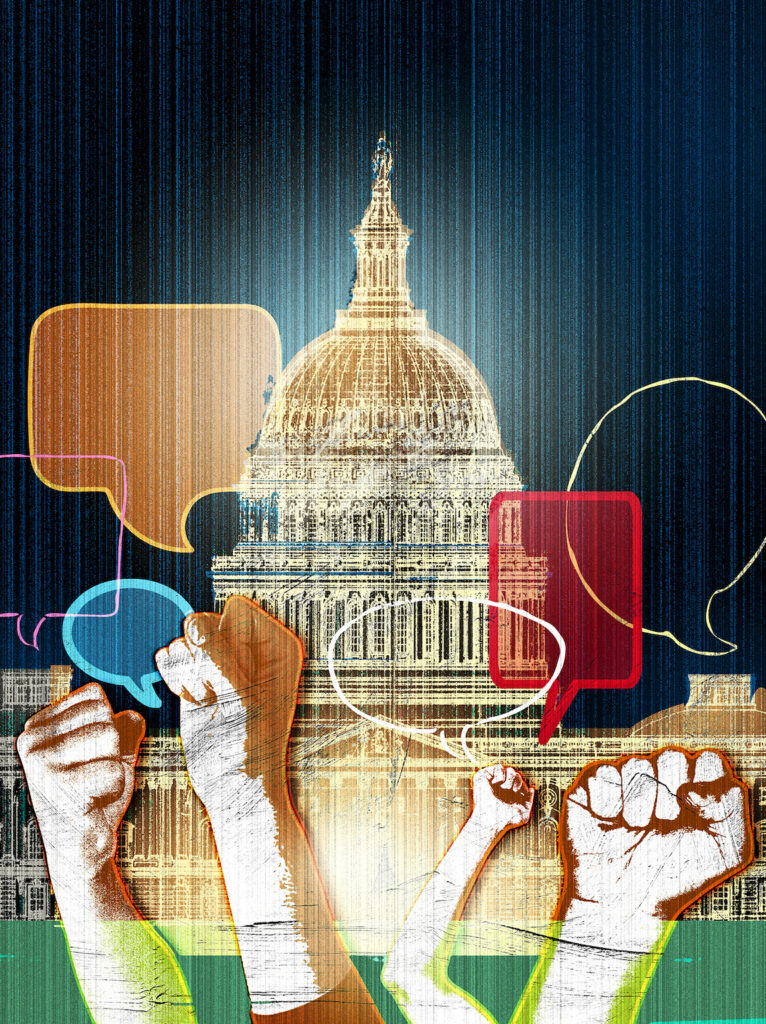ECHO CHAMBERS
Analysis: social media and democracy

By Michael Humphrey | Jan. 3, 2024
YOU CAN HARDLY MENTION “democracy” without raising the issue of social media: Online platforms, such as Facebook, Instagram, and X, have become a leading way Americans experience democracy – and have dramatically influenced what people think about our form of governance.
In fact, even the definition of democracy is often debated online: “We are NOT A DEMOCRACY, we are a CONSTITUTIONAL REPUBLIC,” one recent post on X said. That sounds like a statement of fact, but it is more than that. It is an often-repeated phrase in a larger narrative that implies we are so divided as a nation we cannot even agree on the roots of our government.
For the past decade, researchers have studied the effect of social media on democracy. Like most relationships, it’s complicated. In 2017, a large analysis by U.S. and European scholars concluded that, “Social media itself is neither inherently democratic nor nondemocratic, but yet another arena in which political actors contest for power.”
On one hand, social media has allowed movements such as the Arab Spring and Black Lives Matter to gain a foothold in the social discourse.
On the other hand, researchers have found that misinformation spreads exponentially faster online than accurate information. Even as our democracy was being formed, Founding Father Thomas Jefferson foresaw the significance of sound information: “[W]herever the people are well informed, they can be trusted with their own government,” he wrote.
To a degree, the spread of misinformation is accelerated by bots, the automated software applications that perform repetitive tasks to simulate human activity. Yet, misinformation spreads to an even greater degree by people sharing erroneous posts, likely because of misinformation’s novelty and its proclivity to fill echo chambers of bias confirmation. Greater share rates activate platform algorithms to spread misinformation even further.
Last year, Pew Research Center demonstrated how complicated the relationship between social media and democracy is around the world: 73 percent of people surveyed reported they are more informed because of social media, while 84 percent also said it is easier to manipulate information on these platforms. Then there are the massive tech companies that profit from divisive rhetoric, which captures more eyeballs and clicks than reasoned argument. These companies fight new technologies that exacerbate the problem, though sometimes half-heartedly.
The 2024 elections will contend with artificial intelligence producing ever-more sophisticated bots, “deep fake” videos and audios that represent people doing and saying things they never did, and the fracturing of social media platforms into venues where users’ preferred messages can be iterated without disruption – representing a palace of echo chambers.
While misinformation and fake messages have become common on social media platforms, we are also paying closer attention to them, the Pew study shows. This is problematic in part because most of us have increasingly narrow media diets, researchers have concluded, meaning we are less likely to self-correct our misunderstandings.
The filters that are most worrisome exist in our minds rather than our phones, and those filters are generally enmeshed with the narratives we hold about reality. Healthy news and healthy minds engage in the complexities of the world, reflect on the limitations of our singular perspectives, and are comfortable with the shades of gray that emerge in the messiness of a democratic republic. Fake news and false narratives distort, oversimplify, finish the argument, and claim victory.
Democracy is precarious because it takes a well-informed populace to fulfill its potential. In a media landscape where the loudest hyperpartisan voices compete, it is tempting to let them go on bloviating, pick a side, and get on with living. Democracy asks that we resist that temptation, because there’s more to the story than what meets the feed.
Michael Humphrey is an assistant professor in the CSU Department of Journalism and Media Communication. He researches and teaches at the confluence of narrative and listening theory, with an expertise in how narratives emerge on digital platforms.
Illustration at top: Roy Scott
SHARE
